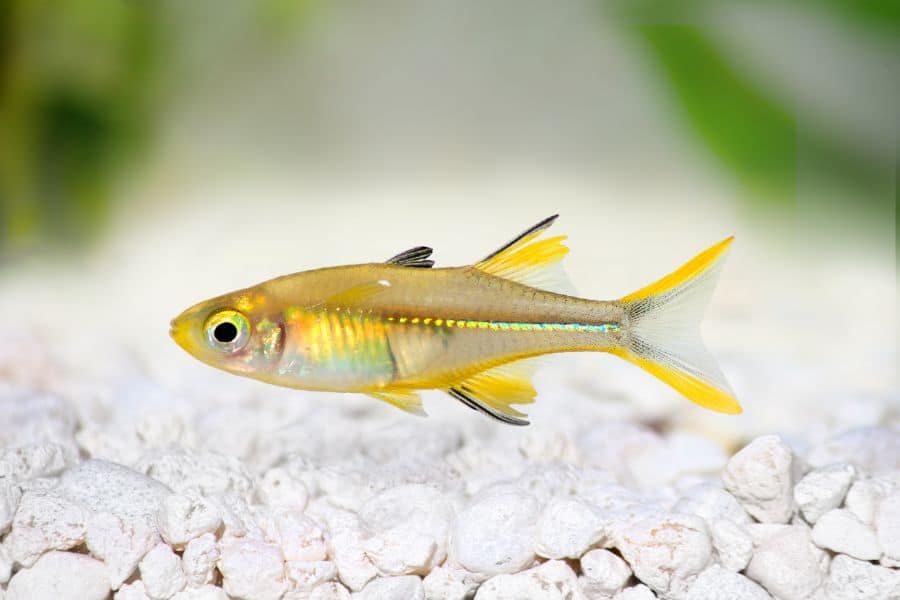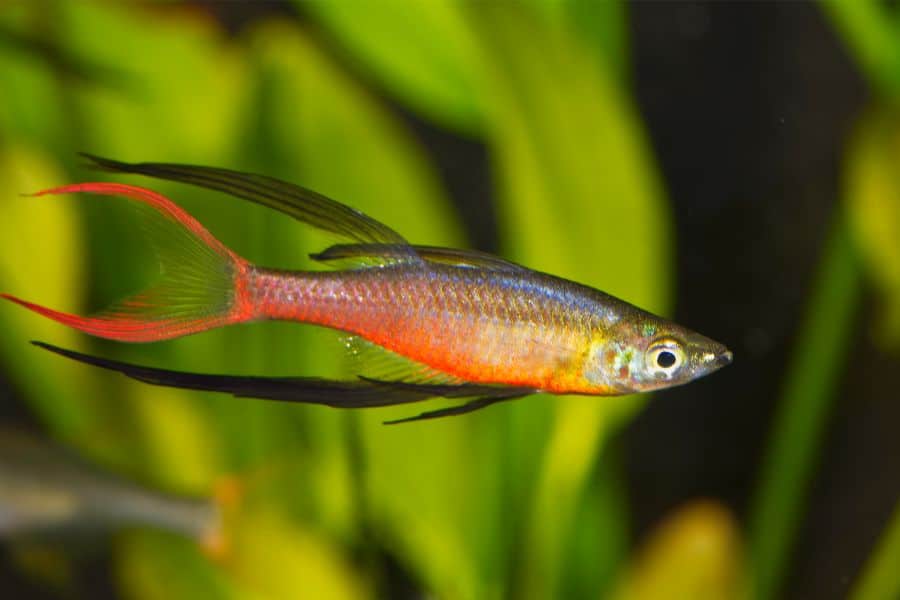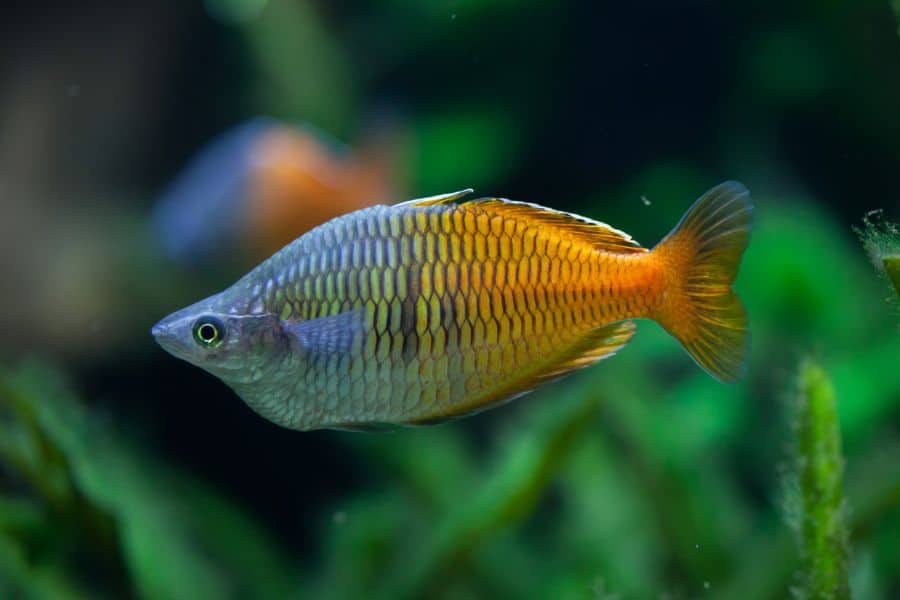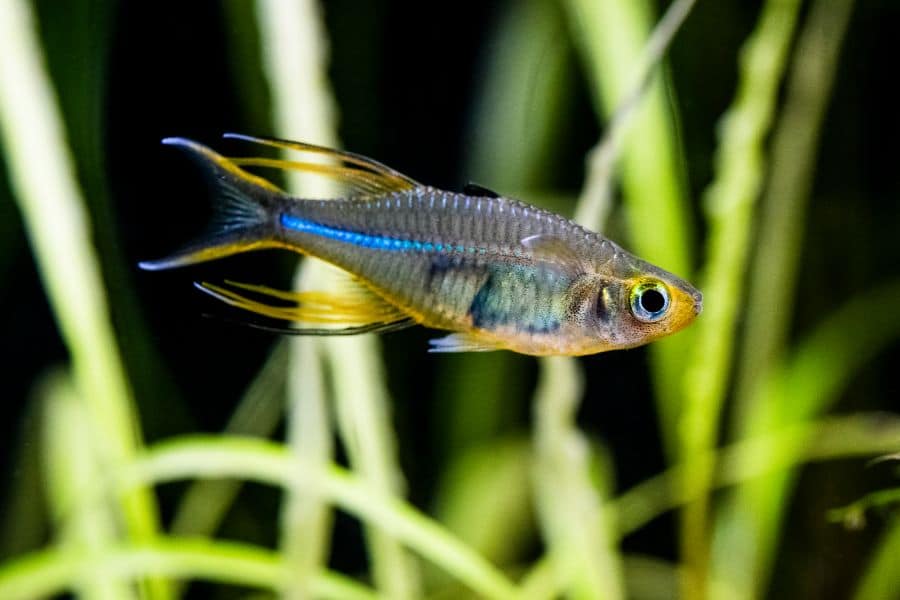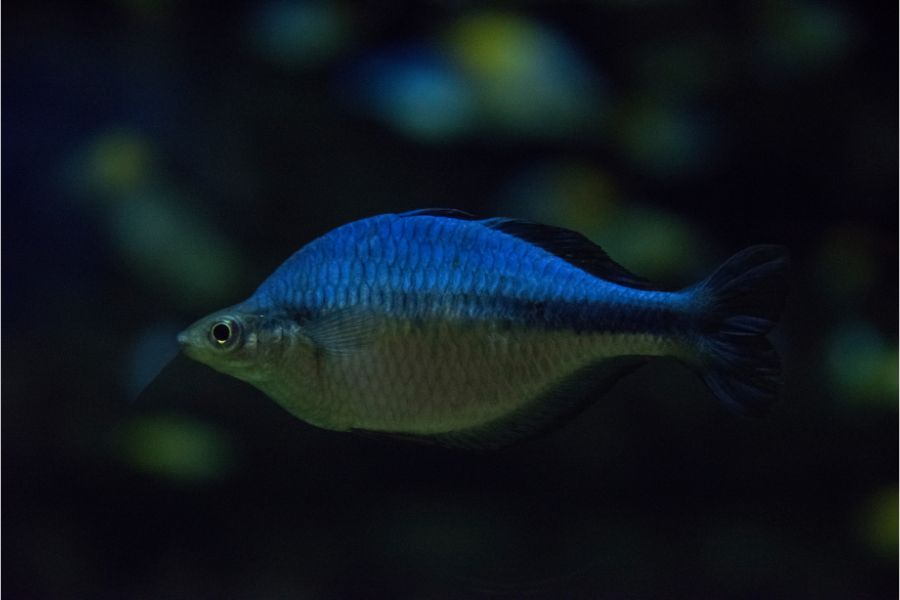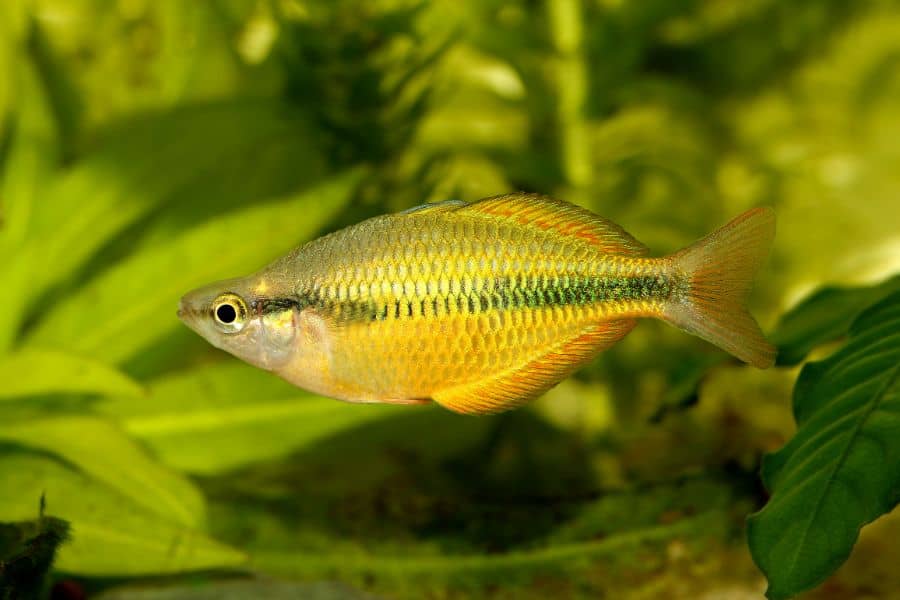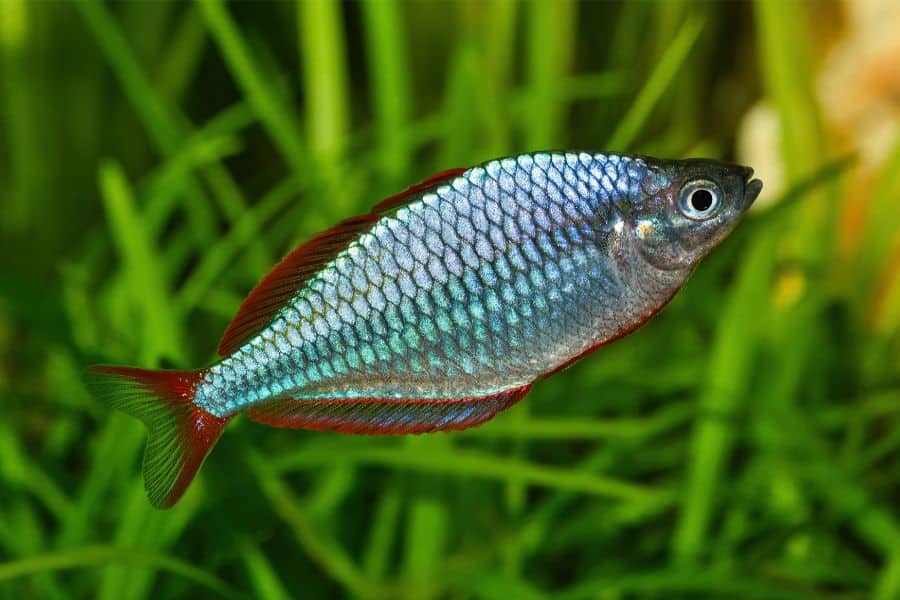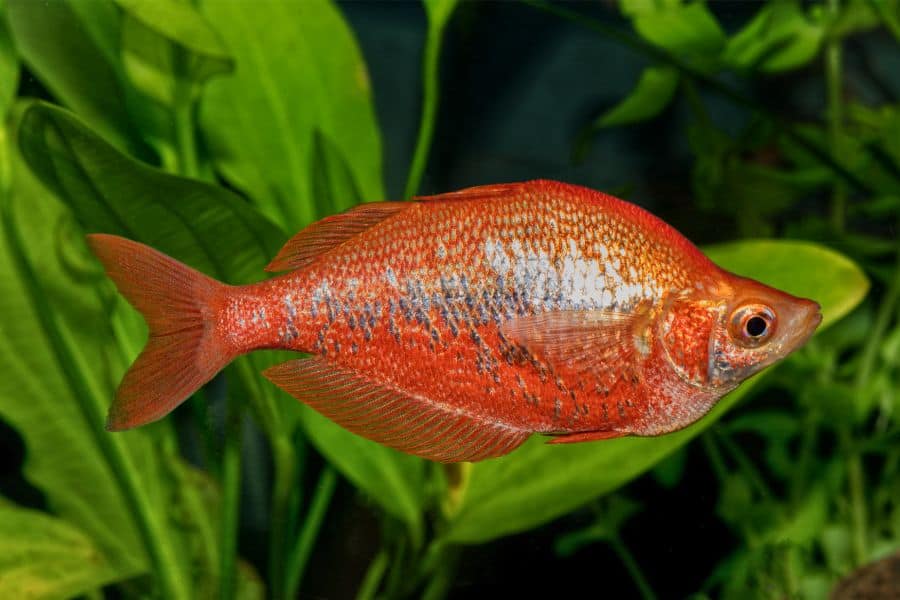Are you looking for new, exciting species that will add a vibrant splash of color to your tank? You can never go wrong with the rainbowfish!
It is almost impossible to describe how beautiful rainbowfish are since they come in a kaleidoscope of colors, most of which are iridescent and change and intensify under bright lights.
Peaceful and good-natured, a community tank would be a delightful place to house these good-looking fish. Unlike cichlids, rainbowfish simply go about their own business.
But what exactly are rainbowfish? Are they saltwater or freshwater fish? With over a hundred species, it can be overwhelming to choose which ones are best for you.
An Overview of the Rainbow Fish
| Family | Melanotaeniidae |
| Common Names | Rainbow Fish, Rainbowfish |
| Subfamilies | Bedotiinae (Madagascar rainbowfishes), Melanotaeniinae, Pseudomugilinae (Blue Eyes), Telmatherininae (Celebes rainbowfishes) |
| Origins | Papua New Guinea, Indonesia, Sulawesi, Madagascar, and Australia |
| Lifespan | 1 to 11 years, depending on species |
| Average Size | Ranging between 5 and 6 inches, with some species reaching up to 7.9 inches |
| Temperament | Peaceful, shoaling |
| Tank Level | All levels |
| Tank Size | Starts at 30 gallons |
| pH Level | 6.8-7.2 |
| Hardness | 10-20 dGH |
| Temperature Range | 72-82°F (22-28°C) |
| Diet | Omnivore |
| Breeding | Egg layer |
| Ideal Setup | Planted aquarium with moderate to strong current |
What Is a Rainbow Fish?
“Rainbowfish” is an umbrella term for a diverse group of freshwater fishes in the Melanotaeniidae family. This family is divided into four subfamilies, with a total of 17 different genera.
The term may also refer to some Labridae family fish. These are marine fish that can be found on coral reefs all over the world. However, only a few species in this family are referred to as rainbowfish.
Therefore, the focus of this article is on freshwater species.
Origin and Habitat
Rainbowfish are native to the lakes, streams, and rivers of New Guinea, Sulawesi, Madagascar, Indonesia, and Australia. Most rainbowfish prefer areas with dense vegetation, as it gives them places to rest and hide.
It is important for rainbowfish to live in groups regardless of their size to thrive. In other words, if you choose a species of rainbowfish that is bigger, you’ll also need a larger tank.
Rainbowfish Subfamilies
Rainbowfish, as previously stated, are divided into four subfamilies, and each subfamily has distinct characteristics.
Bedotiinae Rainbowfish
The 16 recognized species of this subfamily, also known as Madagascar rainbowfish due to their endemism to Madagascar, share one feature: they have elongated, laterally compressed bodies that rarely exceed 4 inches in length.
Melanotaeniinae Rainbowfish
Melanotaeniinae is the largest subfamily, with over 111 recognized species, 86 of which belong to the genus Melanotaenia.
Its scientific name is derived from the ancient Greek melano, which means “black,” and taenia, which means “black-banded.” Melanotaeniinae rainbowfishes feature striking lateral black bands running along their bodies.
Rainbowfish of the genus Melanotaeniinae grow to be between 2.4 and 4.7 inches long. Some species can grow to be 7.9 inches long.
While some members of this subfamily are found outside of Australia, the vast majority are exclusive to the waterways of this vast continent.
Pseudomugilidae Rainbowfish
The Pseudomugilidae subfamily is endemic to Australia and New Guinea. All 19 members possess enchanting blue eyes, which makes them stand out from the rest. These blue-eyed fish are usually no more than 2 inches long.
Telmatherininae Rainbowfish
Also called Celebes rainbowfish, this subfamily is endemic to Sulawesi, Indonesia, formerly known as Celebes.
Members of this subfamily range in size from 1.2 to 3.1 inches, but species in the Paratherina genus can grow to be nearly twice that size.
The most distinctive feature of the Telmatherininae rainbowfish is their bright-colored dorsal fins, which resemble sails.
Different Types of Freshwater Rainbowfish
There are more than 50 species of rainbowfish. To help you decide which species to add to your community tank, let us start with the most well-liked species in the hobby.
Threadfin Rainbowfish
- Scientific name: Iriatherina werneri
- Length: 1.6 inches
- Lifespan: 3 to 5 years
The Iriatherina werneri from Indonesia is the smallest rainbowfish you can find in the hobby. It is, interestingly, the only member of its genus.
Threadfins or Featherfin have long, gorgeous fins and slender bodies. In addition to their elongated fins, males are characterized by their faint vertical stripes and red or orange caudal fins.
Keep them in a group of at least six, preferably ten or more, to promote healthy natural shoaling behaviors.
Threadfins are an excellent choice for a well-planned aquascape. However, due to their size, they are not appropriate for the general community tank.
Threadfins are best kept alone or alongside other nano fish that don’t have nipping behaviors.
Gertrude’s Spotted Blue-Eye Rainbowfish
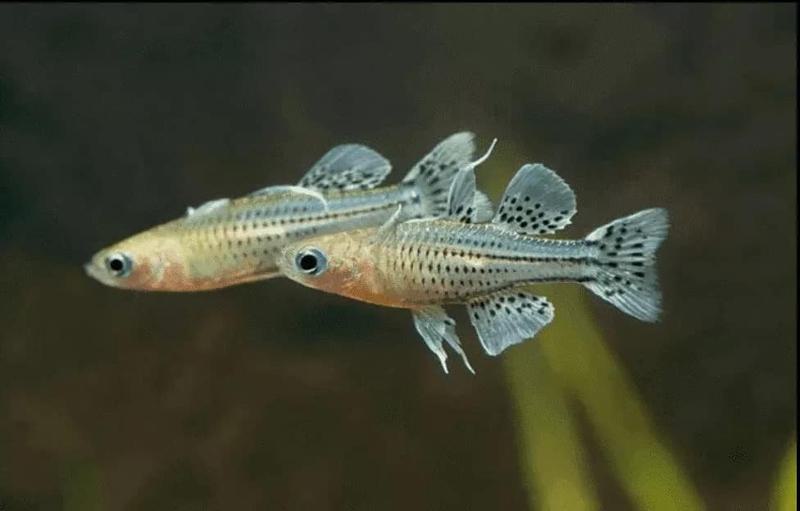
- Scientific name: Pseudomugil gertrudae
- Length: 1.5 inches
- Lifespan: 1.5 years
With its long, wide, fan-like dorsal and anal fins, the Gertrude’s Spotted Blue-Eye rainbowfish appears to have been sent down the fashion runway! However, only mature males get to flaunt such features, and they do so to win a female’s attention.
Males, especially when competing with other males, exhibit iridescent yellow and blue coloration on their bodies and fins. Females are typically smaller and often possess an orange-yellow hue.
Regardless of sex, the Gertrude’s Spotted Blue-Eye rainbowfish can easily scale up the beauty of your tank.
These exotic fish congregate in large schools in densely forested areas of Indonesia, New Guinea, and Australia. Having said that, they are excellent candidates for the planted aquarium.
The only downside is that these fish don’t live long enough.
Forktail Rainbowfish
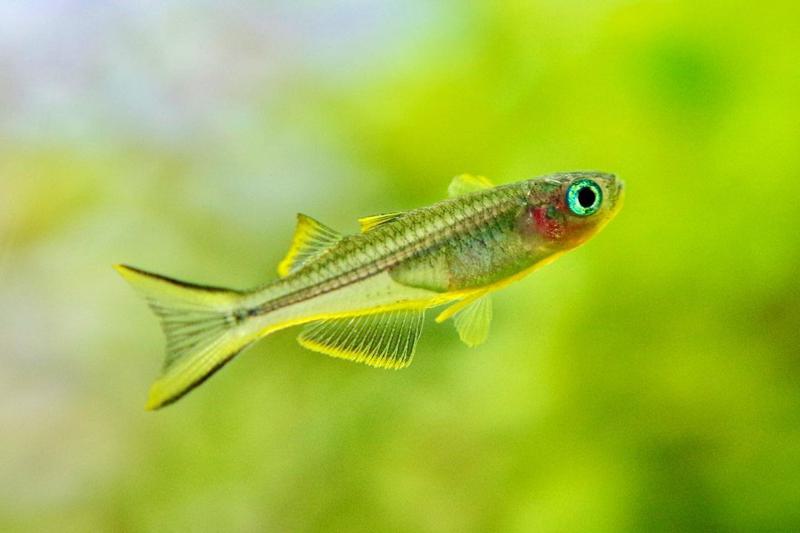
- Scientific name: Pseudomugil furcatus
- Length: 2.5 inches
- Lifespan: 3 years
Tucked away in Papua New Guinea’s dense rainforest are the beautiful Forktail rainbowfish, also known as Furcata rainbowfish. These petite fish dwell in crystal-clear streams teeming with vegetation.
It is already obvious that these cute fish have forked tails, but what’s even more interesting is that there’s a forked pattern inside them, too.
Forktail rainbowfish have silver bodies with bright yellow stripes. But their most eye-catching feature has to be their icy blue eyes, reminiscent of the White Walkers in Game of Thrones!
These fish have upturned pectoral fins, which are translucent. But because of their yellow tips, they look as though they are waving little pom poms as they swim around.
Axelrod Rainbowfish
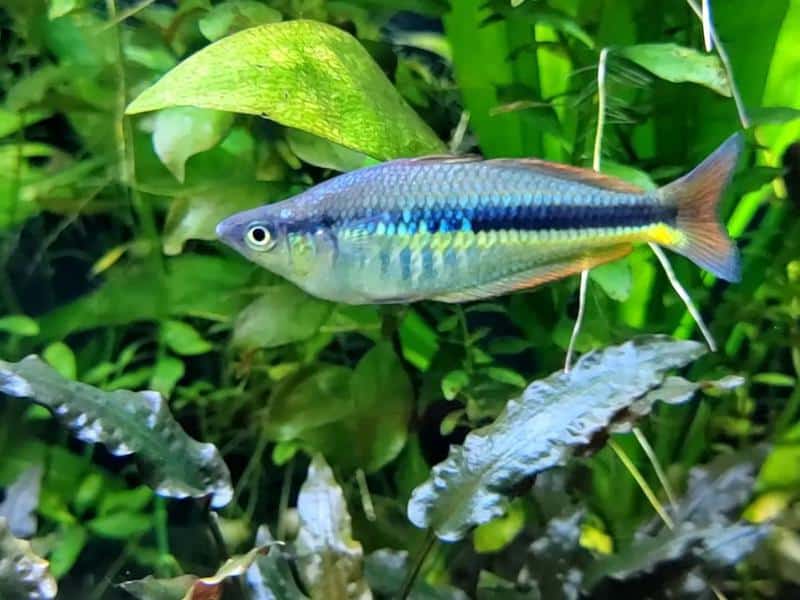
- Scientific name: Chilatherina axelrodi
- Length: 4 inches
- Lifespan: 5 years
Named after the tropical fish expert Herbert Axelrod, this species hails from the Yungkiri Stream of Papua New Guinea.
The Axelrod rainbowfish has a teal-blue coloration above its lateral line and a silver-gray coloration below.
Black spots are scattered across the lateral line, while faint black vertical stripes cover the abdominal area. Some of its fins have a golden-yellow tinge.
Axelrods are fantastic fish for beginners to have, as they are easy to care for. A dark-colored substrate works best to bring out the natural color of the fish.
Banded Rainbowfish

- Scientific name: Melanotaenia trifasciata
- Length: 6 inches
- Lifespan: 5 to 8 years
Native to the northern regions of Australia, Banded rainbowfish are rising in popularity due to their vibrant patterns, lively personalities, and ease of care.
True to their name, Banded rainbowfish feature a thick, dark mid-lateral band. An arched back and narrow head are also their trademarks.
Like the majority of rainbowfish, the color of this species can vary slightly depending on where it was caught.
Since males can grow up to 6 inches long, you need a fish tank that is at least 4 feet tall and has a secure cover to prevent them from jumping out.
Boesemani Rainbowfish
- Scientific name: Melanotaenia boesemani
- Length: 5 inches
- Lifespan: 5 to 8 years
If you are looking for the perfect statement piece for a medium-sized community aquarium, you can’t go wrong with the Boesemani rainbowfish from Indonesia.
The Boesemani rainbowfish is one of the most recognizable rainbowfish in the hobby due to its striking two-toned body.
Males feature a shiny blue front and an orange back. And compared to their smaller cousins, they have more almond-shaped profiles.
This schooling species thrive when kept with other fast-swimming fish of comparable size. Sparring between mature males can occur, but these are usually harmless duels.
Celebes Rainbowfish
- Scientific name: Marosatherina ladigesi
- Length: 3 inches
- Lifespan: 4 years
The Celebes rainbowfish is one of the smallest species in the Melanotaeniidae family. Its scientific name honors both its discoverer, Werner Ladiges, and the village where it was discovered.
The Celebes rainbowfish is a slender fish with a horizontal neon blue stripe down the back half of its body.
It has two dorsal fins: one that is small and black, and another that is larger and two-toned. The rest of the fins are lemon yellow with black markings.
The pectoral fin is either black- or white-tipped or completely translucent. Sometimes, a Celebes rainbowfish can look like it has a forked tail.
Because these rainbowfish are fast swimmers, you must give them enough room to move around.
Crimson-Spotted Rainbowfish
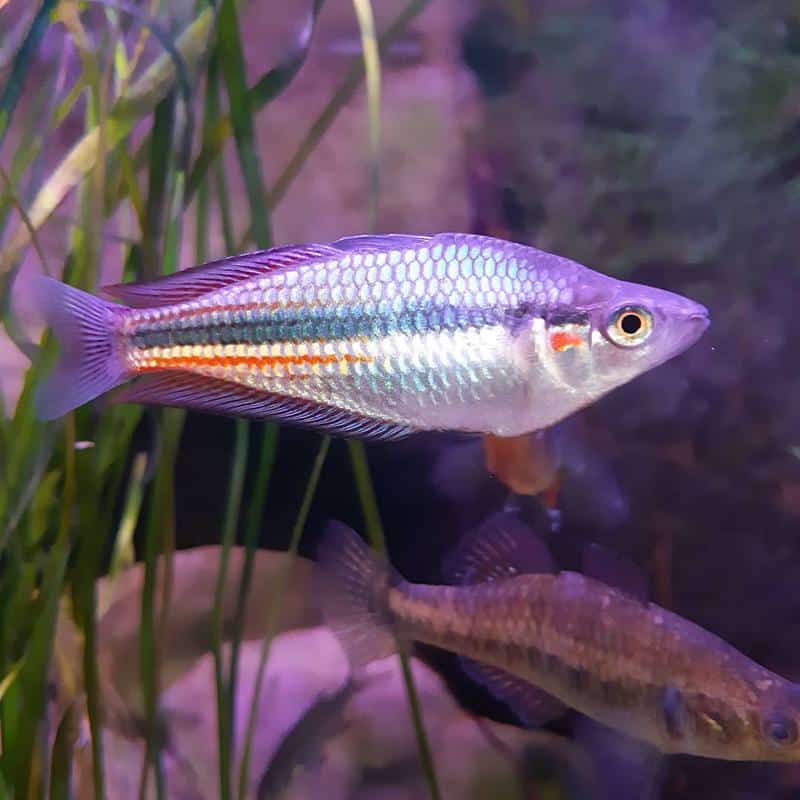
- Scientific name: Melanotaenia duboulayi
- Length: 4.5 inches
- Lifespan: 3 years
The Crimson-Spotted Rainbowfish, also called Duboulay’s Rainbowfish, is believed to be Australia’s original rainbowfish. This species is named for the crimson-red spot found on both sides of their gill covers.
The red-cheeked fish features a wide gray body with a broad stripe of magnificent blue running along the sides and two transverse bands of rich scarlet extended on the upper part of the fish towards the middle of the body.
These hardy fish tolerate wide yet stable water parameters and are happiest in dimly lit environments.
Desert Rainbowfish
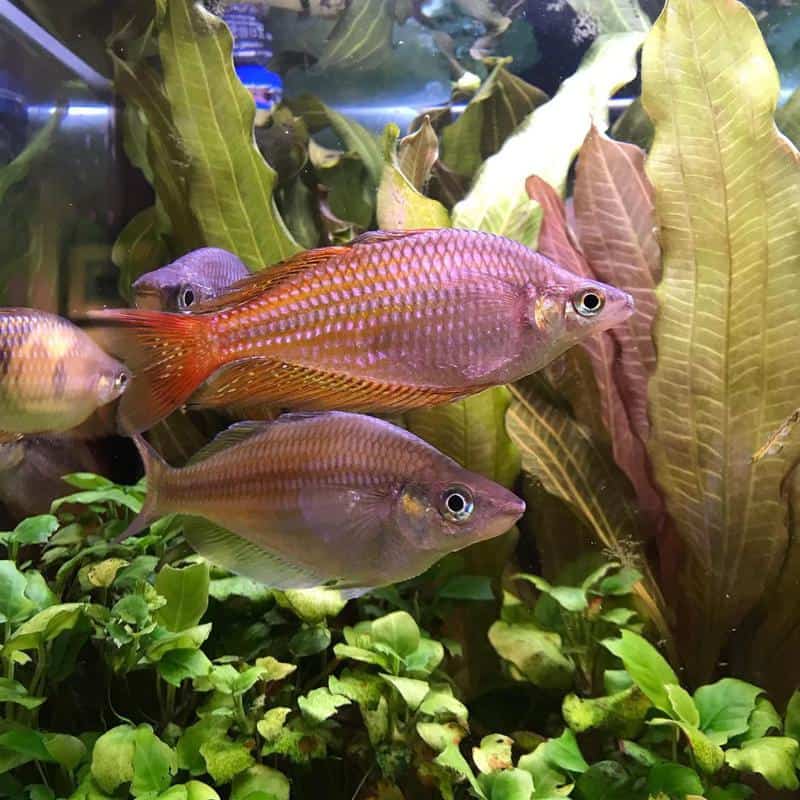
- Scientific name: Melanotaenia splendida tatei
- Length: 4 inches
- Lifespan: 5 years
This species of rainbowfish is named as such, as it hails from the scorching desert of Central Australia. This hardy species has thriving populations in slow-flowing and still habitats where they breed in large numbers.
These fish are usually silver and iridescent, with a yellow and green checkered pattern on their fins.
Lake Kutubu
- Scientific name: Melanotaenia Iacustris
- Length: 5 inches
- Lifespan: 5 years
You no longer have a reason to be blue. You can now add a splash of sapphire to your tank with this rainbowfish from Lake Kutubu (Turquoise Rainbowfish)!
The Lake Kutubu Rainbowfish boast shimmering scales of teal or cobalt blue on their upper bodies, which fade into a green hue. These fish have narrow, triangular heads and elongated bodies that deepen with age.
There is a wide range of compatible tankmates for this species. Their medium size makes them a good dither fish for semi-aggressive fish like cichlids. However, these rainbows need to be in a group of at least eight for them to feel at home.
Lake Tebera
- Scientific name: Melanotaenia herbertaxelrodi
- Length: 4 inches
- Lifespan: 5 years
Rainbowfish from Lake Tebera have golden yellow bodies decorated with a black mid-lateral stripe. Their dorsal, anal, and caudal fins have a red or yellow tint.
Their peaceful nature makes them fantastic additions to community tanks with a heavily planted setup.
The water flow should be slow, and the tank should be large enough to accommodate each fish. These fish do not do well in soft, acidic environments, but they are otherwise easy to care for.
Lake Wanam Rainbowfish
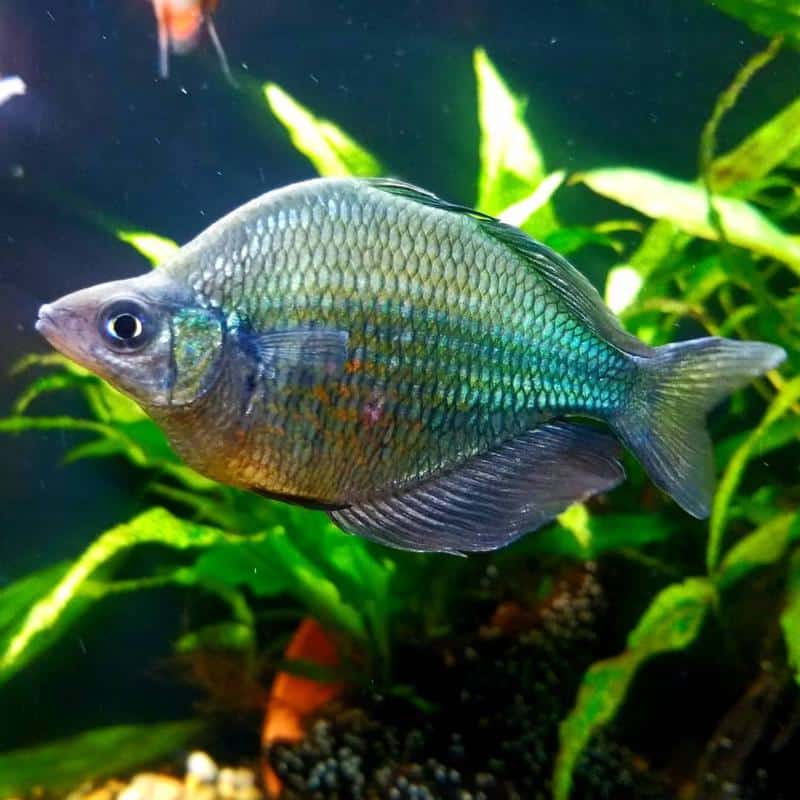
- Scientific name: Glossolepis wanamensis
- Length: 3 inches
- Water parameters: 78.8-86℉, 7-8 pH, 10-20 dGH
- Lifespan: 5 years
This rainbowfish from Lake Wanam has a metallic green body with a rosy flush underneath its gills.
The anterior scales below the lateral line are marked with narrow orange lines that become green or bluish towards the tail. The anal fin of the male is large and elongated, reaching a depth of nearly an inch.
Sadly, the Lake Wanam Rainbowfish is now listed as a critically endangered species due to competition against some invasive species of tilapia. If you want these fish, you can get them from specialized breeders.
Madagascar Rainbowfish
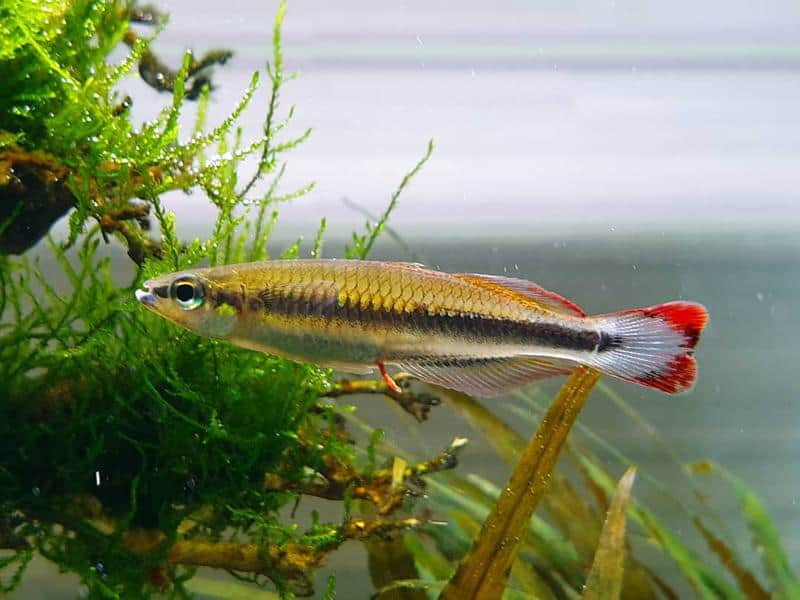
- Scientific name: Bedotia madagascarensis
- Length: 3.9 inches
- Lifespan: 5-11 years
The Madagascar Rainbowfish is easily identified by its torpedo-shaped body, light yellowish-brown coloration. A black line with a metallic blue sheen runs parallel across its body, and a second, shorter, fainter line runs beneath the first.
The tails and fins of male Madagascars are outlined in red. Females, on the other hand, look just like males except that they have faintly colored or clear fins.
When kept in a large group, the Madagascan rainbowfish gets along well with South American cichlids that require similar water conditions, such as Discus and Angelfish. These petite fish also enjoy strong currents in their tank.
Murray River Rainbowfish
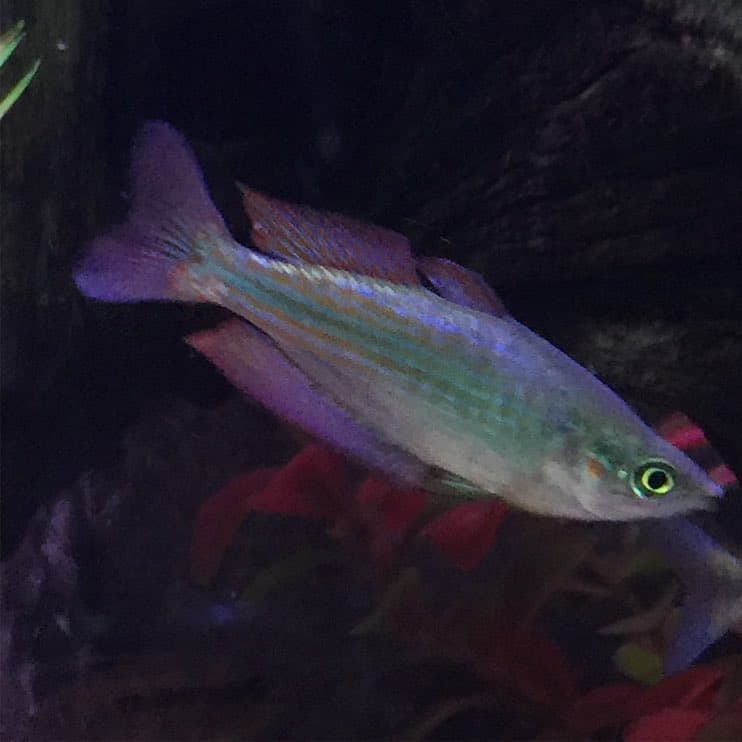
- Scientific name: Melanotaenia fluviatilis
- Length: 4.5 inches
- Lifespan: 3 years
The Murray River Rainbowfish have silver bodies with green-tinged scales and yellow, red, or orange fins.
Like many other rainbowfish, the males will be urged to show off their best colors in the company of females. A vivid orange stripe will appear on their backs, indicating that the males are ready to spawn.
They can be quite skittish when kept in small numbers. So, keep them in a shoal of at least eight, ideally more. A tank of sufficient size would be needed to accommodate a very large group.
These rainbowfish feel most at home in a densely planted aquarium. While they are peaceful, their size and swift movements may disturb smaller, slower-moving fish.
Neon Rainbowfish
- Scientific name: Melanotaenia praecox
- Length: 2.5 inches
- Lifespan: 3 to 4 years
The Neon Rainbowfish is native to the Mamberamo River in West Papua and the jungle streams of Western New Guinea.
These petite almond-shaped fish are named for their neon blue and green coloration that flashes under the light. Given their smaller size, they prefer to be in a large group of 10 or more.
Despite their small size, these fish are not recommended for beginning aquarists due to their hypersensitivity to changes in water conditions and water parameters.
Red Irian Rainbowfish
- Scientific name: Glossolepis incisus
- Length: 6 inches
- Lifespan: 5 years
Red Irian rainbowfish easily add a rich diversity of colors to your tank. While males come in bright red, females have silver bodies with yellow and green undertones.
Red Irian rainbowfish can grow to be six inches long and resemble the shape of an American football.
Despite their potential for growth, it is crucial to keep these fish in groups of at least 10 that include both sexes. You, therefore, need a sizable aquarium!
The males enjoy enhancing their coloration and putting on amazing displays to attract females. But in the case of Red Irians, they lose their color rather quickly when there are no females nearby.
Final Words
Rainbowfish require well-oxygenated water in their home aquarium. Because these fish come from different parts of the world, their water quality requirements will vary. Therefore, you must check the water parameters before housing two or more rainbowfish in the same tank.
Bear in mind that most species of rainbowfish will have less colorful females. Regardless, keep more females than males to deter male aggression.
Males lose their luster in the absence of females. Sparring between males may still occur, and often, these so-called duels are harmless dances to show off which fish is more attractive.
